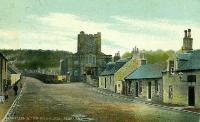Muirkirk
Information specific to this area can be found below and on the left
menu bar. We also recommend consulting the many general pages for
information of general relevance to miners' lives.
Ordnance Gazetteer of Scotland, Francis H Groome, 1885
Muirkirk, a town and a parish in the NE of Kyle district, Ayrshire. The town, lying near the right bank of the Ayr, 720 feet above sea-level, has a station, the junction of the Douglasdale branch of the Caledonian with the Muirkirk branch of the Glasgow and Southwestern railway, 10 1/4 miles ENE of Auchinleck, 25 3/4 E by N of Ayr, 57 3/4 SSE of Glasgow (only 30 by road), and 49 3/4 SW of Edinburgh. "With environs bleaker perhaps than those of any other town in Scotland, Leadhills and Wanlockhead alone excepted, it is the seat of an extensive iron manufacture, and was brought into existence through the discovery and smelting of iron ore (1787). A small predecessor or nucleus existed previously under the name of Garan ; and the transmutation of this into the town of Muirkirk is noticed as follows in the Old Statistical Account :- 'The only village, or rather clachan, as they are commonly called, that deserves the name, lies at a small distance from the church, by the side of the high road, on a rising ground called Garanhill, which therefore gives name to the range of houses that occupy it. They have increased greatly in number since the commencement of the works ; and new houses and streets have risen around them. Many houses besides, some of them of a very neat structure, have been built at the works themselves; and others are daily appearing that will, in a short time, greatly exceed in number and elegance those of the old village, formerly, indeed, the only one that the parish could boast.' The place has undergone great fluctuations of prosperity ; but, during the last half century, and especially since the formation of the railway, it has been very flourishing, insomuch as to rank among the great seats of the iron manufacture in Scotland. The works of the Eglinton Iron Company have 3 blast furnaces, 10 puddling furnaces, and 2 rolling mills, for the manufacture of pig and malleable iron ; and coal-mining and lime-burning are actively carried on. New works for collecting ammonia as a by-product at the furnaces were erected at a large outlay in 1883. Muirkirk has a post office with money order, savings' bank, and telegraph departments, a branch of the Clydesdale Bank, 2 hotels, a gas company, a good library, hiring fairs on the Tuesday after 18 Feb and the Thursday after 18 Dec., and a cattle and sheep fair on the second Friday in June. The parish church, built in 1812, and renovated in 1883 at a cost of £1700, contains 800 sittings. Other places of worship are a Free church built soon after the Disruption, a U.P. church (1823; 380 sittings), and St Thomas' Roman Catholic church (1856 ; 250 sittings), which last was enlarged and improved in 1882, when a presbytery also was built at the cost of the Marquess of Bute. Pop. (1861) 2281, (1871) 2376, (1881) 3470, of whom 1861 were males. Houses (1881) 637 inhabited. 32 vacant. 2 building
Glenbuck, a village amid the hills of Muirkirk parish, E Ayrshire, within 7 furlongs of the Lanarkshire border, and near a station of its own name on the Douglasdale branch of the Caledonian, 3 1/2 miles ENE of Muirkirk town. It has large coal and lime works, a post office under Lanark, a public school, and an Established chapel of ease (1881). Near the station are two reservoirs - the Upper (5 3/4 by 2 furl.) and the Lower (4 by 1 furl.). They were formed about 1802 to furnish water power to cotton works at Catrine. The House of Glenbuck is a mansion of recent erection, the seat of Charles Howatson, Esq. of Glenbuck. Pop. of village (1851) 237, (1871) 311, (1881) 858.
